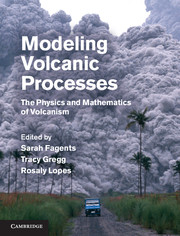Book contents
- Frontmatter
- Contents
- Contributors
- Chapter 1 Introduction
- Chapter 2 Magma chamber dynamics and thermodynamics
- Chapter 3 The dynamics of dike propagation
- Chapter 4 Dynamics of magma ascent in the volcanic conduit
- Chapter 5 Lava flows
- Chapter 6 Unsteady explosive activity
- Chapter 7 Unsteady explosive activity
- Chapter 8 Sustained explosive activity
- Chapter 9 Modeling tephra sedimentation from volcanic plumes
- Chapter 10 Pyroclastic density currents
- Chapter 11 Magma–water interactions
- Chapter 12 Deep-sea eruptions
- Chapter 13 Volcano–ice interactions
- Chapter 14 Modeling lahar behavior and hazards
- Chapter 15 Introduction to quantitative volcano seismology
- Chapter 16 Volcano acoustics
- Chapter 17 Planetary volcanism
- Index
- Plate section
- References
Chapter 4 - Dynamics of magma ascent in the volcanic conduit
Published online by Cambridge University Press: 05 March 2013
- Frontmatter
- Contents
- Contributors
- Chapter 1 Introduction
- Chapter 2 Magma chamber dynamics and thermodynamics
- Chapter 3 The dynamics of dike propagation
- Chapter 4 Dynamics of magma ascent in the volcanic conduit
- Chapter 5 Lava flows
- Chapter 6 Unsteady explosive activity
- Chapter 7 Unsteady explosive activity
- Chapter 8 Sustained explosive activity
- Chapter 9 Modeling tephra sedimentation from volcanic plumes
- Chapter 10 Pyroclastic density currents
- Chapter 11 Magma–water interactions
- Chapter 12 Deep-sea eruptions
- Chapter 13 Volcano–ice interactions
- Chapter 14 Modeling lahar behavior and hazards
- Chapter 15 Introduction to quantitative volcano seismology
- Chapter 16 Volcano acoustics
- Chapter 17 Planetary volcanism
- Index
- Plate section
- References
Summary
Overview
This chapter presents the various mechanisms and processes that come into play within the volcanic conduit for a broad range of effusive and dry explosive volcanic eruptions. Decompression during magma ascent causes volatiles to exsolve and form bubbles containing a supercritical fluid phase. Viscous magmas, such as rhyolite or crystal-rich magmas, do not allow bubbles to ascend buoyantly and may also hinder bubble growth. This can lead to significant gas overpressure and brittle magma fragmentation. During fragmentation in vulcanian, subplinian, and plinian eruptions, gas is released explosively into the atmosphere, carrying with it magma fragments. Alternatively, high viscosity may slow ascent to where permeable outgassing through the vesicular and perhaps fractured magma results in lava effusion to produce domes and flows. In low-viscosity magmas, typically basalts, bubbles may ascend buoyantly, allowing efficient magma outgassing and relatively quiescent magma effusion. Alternatively, bubbles may coalesce and accumulate to form meter-size gas slugs that rupture at the surface during strombolian eruptions. At fast magma ascent rates, even in low-viscosity magmas, melt and exsolved gas remain coupled, allowing for rapid acceleration and hydrodynamic fragmentation in hawaiian eruptions.
Introduction
In the broadest sense, volcanic eruptions are either effusive or explosive. During explosive eruptions magma fragments and eruption intensity is ultimately related to the fragmentation mechanism and associated energy expenditure (Zimanowski et al., 2003). If the cause of fragmentation is the interaction of hot magma with external water, the ensuing eruption is called phreatomagmatic. Eruptions that do not involve external water are called “dry,” in which case the abundance and fate of magmatic volatiles, predominantly H2O and CO2, as well as magma rheology and eruption rate, are the dominant controls on eruption style. Eruption styles are often correlated with magma composition and to some extent this relationship reflects differences in tectonic setting, which also influence magmatic volatile content and magma supply rate.
- Type
- Chapter
- Information
- Modeling Volcanic ProcessesThe Physics and Mathematics of Volcanism, pp. 55 - 84Publisher: Cambridge University PressPrint publication year: 2013
References
- 72
- Cited by



